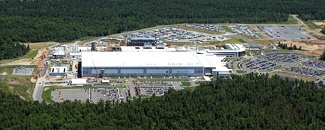Wednesday, August 31st 2016

AMD Announces Amendment to Wafer Supply Agreement With GLOBALFOUNDRIES
AMD announced that it has entered into a long-term amendment to its Wafer Supply Agreement (WSA) with GLOBALFOUNDRIES Inc. (GF) for the period from Jan. 1, 2016 to Dec. 31, 2020. "The five-year amendment further strengthens our strategic manufacturing relationship with GLOBALFOUNDRIES while providing AMD with increased flexibility to build our high-performance product roadmap with additional foundries in the 14 nm and 7 nm technology nodes," said Dr. Lisa Su, AMD president and CEO. "Our goal is for AMD to have continued access to leading-edge foundry process technologies enabling us to build multiple generations of great products for years to come."
GLOBALFOUNDRIES' Fab 8 in Malta, N.Y. is playing a significant role in providing leading-edge capacity for AMD's graphics and processor products, including the recently launched AMD Radeon Polaris GPUs and upcoming "Zen"-based processors.In addition to modifying certain terms of the WSA applicable to AMD's microprocessor, graphics processor, and semi-custom products, the amendment:
GLOBALFOUNDRIES' Fab 8 in Malta, N.Y. is playing a significant role in providing leading-edge capacity for AMD's graphics and processor products, including the recently launched AMD Radeon Polaris GPUs and upcoming "Zen"-based processors.In addition to modifying certain terms of the WSA applicable to AMD's microprocessor, graphics processor, and semi-custom products, the amendment:
- Covers a 5-year period, spanning from calendar year 2016 through 2020;
- Establishes a comprehensive framework for technology collaboration between AMD and GF for the 7nm technology node, building on the success of the 14nm node;
- Provides AMD with the flexibility to manufacture certain products with another wafer foundry;
- Sets annual wafer purchase targets from 2016 through the end of 2020, fixed wafer prices for 2016, and a framework for yearly wafer pricing.
- Make a $100 million cash payment to GF, paid in installments beginning in Q4 2016 through Q3 2017.
- Make quarterly payments to GF beginning in 2017 based on the volume of certain wafers purchased from another wafer foundry.
- Grant to West Coast Hitech L.P., a wholly-owned subsidiary of the Mubadala Development Company PJSC, a warrant to purchase 75 million shares of AMD common stock at a purchase price of $5.98 per share. The warrant may be exercised in whole or in part prior to February 29, 2020. The warrant is only exercisable to the extent that Mubadala or its subsidiaries do not beneficially own, either directly or indirectly, an aggregate of more than 19.99 percent of AMD's outstanding capital stock after the exercise.

14 Comments on AMD Announces Amendment to Wafer Supply Agreement With GLOBALFOUNDRIES
What happens instead is AMD can produce wafers at other foundries, but GloFo gets a cut per wafer.
Obviously not ideal, but not much else AMD could do until 2020.
They aren't distancing themselves from GloFo. Opposite.
----
“I believe a few key customers looked at the 10nm process offering from TSMC and decided it will be better to wait for the 7nm solution,” said Joanne Itow, an analyst with Semico Research. “10nm will not get enough improvement compared to all the time and money required.”
“In general, we are seeing that this financial equation is pretty tight for most customers at 10nm,” GlobalFoundries’ Paggi said. “7nm, for most customers in most of the markets, appears to be a more favorable financial equation.”
semiengineering.com/10nm-versus-7nm/
----
"Provides AMD with the flexibility to manufacture certain products with another wafer foundry;"
There's only one other wafer foundry in town and that's TSMC's 16nm node, which has proved far superior to GloFo's 14nm. So I'm guessing that Vega will be TSMC 16nm, and perhaps even Zen (considering the low clocks on the demo silicon AMD was showing last week). Polaris may get a TSMC respin after the dust has settled from Vega and Zen's launches.
As for this:
"Establishes a comprehensive framework for technology collaboration between AMD and GF for the 7nm technology node, building on the success of the 14nm node;"
Further underlines the fact that GloFo botched 14nm royally, so AMD is going to take a more active involvement in 7nm development. And I'll bet there's an escape clause that says if they don't like what they see, they'll go back to TSMC.
I think that the 7nm developments are also because AMD is the biggest customer at GloFo, and if they can use their foundry experience to tune the 7nm process in a way that best suits their products, then both parties come out winning.
Mind blown.
I remember a few years back, that the contract was so bad that AMD was paying them a few hundred million NOT to produce any cpus. That was just an awful contract from top to bottom.
While it seems encouraging that "Provides AMD with the flexibility to manufacture certain products with another wafer foundry" AMD also has to pay GLOFLO close to 1 billion over the course of a year. Seems like more of the same as before (paying them not to produce more chips)
The issue isnt GF, it's that AMD never had a maxwell-style redesign. What we got in polaris should have been the 300 series, but AMD couldnt get it out until now.
GloFo has a history of fucking up its processes and being late to market, the problem really is is that when AMD became fabless (creating GloFo), one of the conditions of sale was minimum wafer buys until 2020. By the looks, this reengineers this agreement somewhat so AMD can satisfy its minimum wafer buys with purchases at other fabs, as long as GloFo gets a kickback. Obviously not ideal, but a better situation regardless.
Exclusive: A Critical Analysis of AMD's Multi-Year Amendment to The Wafer Supply Agreement 2016